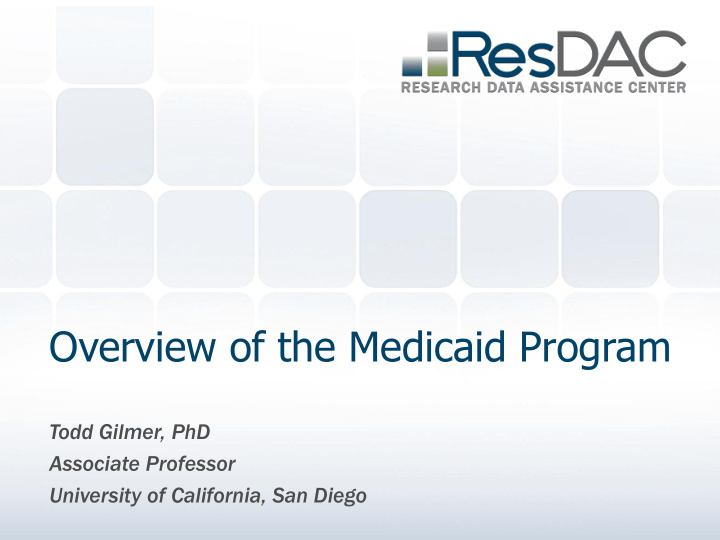



Overview of the Medicaid Program Todd Gilmer, PhD Associate Professor University of California, San Diego
Overview History of Medicaid Medicaid Eligibility and Benefits Medicaid Populations and Expenditures Medicaid Today Medicaid Managed Care Medicaid and Health Reform 2
History of Medicaid 1935 - Social Security Act - Old Age, Survivors, and Disability Insurance Trust Fund (OASDI): retirement, widows, disability: FDR 1935 1965 Title XIX of the SSA created Medicare and Medicaid: LBJ 1965 Medicare federally funded entitlement program Medicaid joint state - federal social welfare program 3
State Variations in Medicaid Feds set basic rules on eligibility and benefits; some mandatory requirements, many state options States administer the program, making many choices on eligibility, covered services, and payment levels Feds pay a percentage of total Medicaid spending: 50% in CA; 85% in poor states; averages 57% 4
5
Medicaid Eligibility To be eligible for Medicaid, a beneficiary must belong to a ‘ Category ’ that is eligible, and meet strict financial tests Categories of eligibility ˗ Poor children, and their parents ˗ Disabled ˗ Elderly 6
Medicaid Eligibility Poor children (up to 100% of FPL) ˗ Up to 133% of FPL if < age 6 Pregnant women up to 185% of FPL Parents (mostly single mothers) if very low income < 100% of FPL in CA ˗ ˗ < 50% of FPL in some states People with disabilities and low income (SSI) Aged with low income (SSI) Disabled and aged in long term care who ‘ spend down ’ to eligibility (MN) Children ’ s Health Insurance Program, enacted in 1997, covering children up to 200%-250% of FPL (not part of Medicaid, but related) 7
8
Restricted Benefits Qualified Medicare beneficiaries (QMBs) and Selected low-income beneficiaries (SLMBs) receive Medicare premium and cost sharing assistance Participants in Family Planning waivers (CA, GA) 9
10
11
Medicaid Eligibility Medicaid is categorically and financially very restrictive (and complicated!) Adults without children never eligible for Medicaid, regardless of how poor (unless disabled or elderly) Low income adults with children ineligible unless very low income Undocumented persons ineligible, except for emergency services 12
Dual Eligibles (Medi-Medi) Disabled and Aged who qualify for SSDI Aged low-income Dual coverage ˗ Medicare is the primary payer for most inpatient and outpatient services and RX (2006) ˗ Medicaid covers co-payments and deductibles, RX prior to 2006, and nursing home services 13
14
15
16
17
18
19
20
FACES of Medicaid II Provide a portrait of Medicaid beneficiaries with multiple chronic conditions Prevalence of chronic conditions Patterns of clustering of conditions Patterns of expenditure 21
Study Population Medicaid Beneficiaries in 2001 & 2002 Excluded states with a high penetration of managed care ˗ AZ, DE, HI, MD, TN, OR Excluded aid categories with a high penetration of managed care » Example: disabled in MI 22
Study Population (continued) Excluded dual eligibles and aged in states where the diagnostic data appear suspect ˗ CT, FL, GA, MI, ND, NH, PA, SD Excluded beneficiaries with fewer than 6 months FFS eligibility Excluded beneficiaries with restricted Medicaid eligibility and benefits 23
24
25
26
27
28
29
30
31
32
33
34
35
36
37
38
39
40
41
42
43
Medicaid Managed Care Waivers (1915(b) and Section 1115) have allowed states to implemented mandatory managed care programs Part of the state, or state-wide Certain or all aid categories MCOs provide encounter data of varying quality 44
Models of Managed Care Risk-based: MCO is paid a fixed monthly fee per enrollee (capitation) and assumes some (partial- risk) or all (full-risk) of the financial risk for the delivery of a range of services FFS Primary Care Case Management (PCCM): PC provider is ‘ gatekeeper ’ to approve and monitor services provided to enrollees 45
Penetration of Managed Care 80% 71% 70% 63% 60% 56% Percent Enrolled in Managed Care 50% 40% 29% 30% 20% 10% 10% 0% 1991 1995 2000 2005 2008 46
47
Medicaid and Health Reform Expands Medicaid to a national floor of 133% FPL ˗ Subsidies for individuals between 133% and 400% FPL through the State Health Exchanges Includes adults without children Income is mod-AGI without asset or resource tests States receive full federal match for new eligibles for three years, then scaling down to 90% States are no longer required to expand Medicaid 48
Medicaid and Health Reform Benchmark benefit package Increases Medicaid payment rates in FFS and managed care for primary care services provided by primary care doctors to 100% Medicare payment rates for two years A new Center for Medicare and Medicaid Innovation will test payment and service delivery models aimed to improve quality and efficiency Funding for pilot programs for medical homes and accountable care organizations, demonstrations integrated / coordinated care for dual eligibles 49
Congressional Budget Office Estimates Medicaid expansion will increase coverage by 16 million ˗ Estimates were made prior to the SCOTUS ruling Most of the cost will be borne by the Federal government ˗ Federal cost of $434 billion and State cost of $20 billion from 2010 to 2019 due to coverage increases 50
Medicaid Summary Medicaid is a primary source of coverage for the poor and disabled Medicaid is financially and categorically restrictive ˗ Poor children, and sometimes their parents Disabled and poor elderly ˗ Medicaid coverage is fairly comprehensive ˗ Inpatient, outpatient, pharmacy, nursing home ˗ Provider payments are low Medicaid generosity varies across states ˗ Eligibility, enrollment, benefits, provider payments 51
Uses of Medicaid Data Large sample sizes Ability to study young women and children Identify more severe, less common conditions among the disabled Study variations in state program characteristics Pharmacy studies 52
Recommend
More recommend